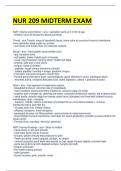NUR 209 MIDTERM EXAM NMT: Infants and Children - ans-- salivation starts at 3 mnth of age - children have 20 temporary deciduous teeth Throat - ans-Tonsils: mass of lymphoid tissue, same color as surround muscus membrane, more glandular deep crypts on surface - oral cavity and throat have rich vascular network Mouth - ans-- Hard -palate: bone whitish color - lips; transition zone - soft palate: pinker mobile arch of muscle - uvula: free projection hanging down middle soft plate - cheeks: side wall of oral cavity - tongue: mass of striated - papillae: rough bumps elevations (dorsal) - vallate papillae: inverted v -shape, posterior tongue - Frenulum: connects tongue to mouth floor - Parotid gland (stensens d uct): submandibular gland (Wharton's duct), sublingual gland - secretes saliva, moistens/libricates food, starts digestion, cleans + protects mucosa Nose - ans-- first segment of respiratory system - kisselbachs plexus - common site of nosebleeds - nose moistens warms and filters inhaled air, sensory organ for smell - superior part is bridge, tip, opening are nares, columella divides two nostrils, ala is lateral wing - nasal cavity: anterior edge has coarse nasal hairs (vibrissae) rest lined with ciliated mucous membranes - dust + bacteria - superior, middle, inferior turbinates (increased SA so more blood vessels + mucous membrane warm and filter air) - sinuses drain into middle meatus - olfactory receptors - smell receptors - paranasal sinuses: air filled pockets, communicate w/ nasal community - lined ciliated mucous membrane, resonates for sound production, provide mucous (drains into nasal cavity) - Frontal sinus, maxillary, ethmoid, sphenoid NMT: Normal Findings - ans-- Nose is midline - nasal cavity is red, and smooth - turbinates same red as mucosa - sinuses: patient should feel pressure/no pain - Teeth are white, evenly spaced, straight, no debris - normal oc clusion back teeth rest directly on top, upper incisors slightly override lower - gums are pink/coral with stippled surface, margins are tight - tongue: pink/even - thin white coating present - saliva present - buccal mucosa: pink, smooth, moist - Stense ns duct: small dimple opposite upper second molar - Hard palate: white, rugae - soft palate: pink, smooth, upwardly moveable - torus palatines: modular bony ridge - uvula: fleshy pendant hanging midline (Ahhh - rises) -tonsils: same pink as oral mucosa, indentations , 1+, 2+ NMT: Subjective Data - ans-NOSE - discharge - frequent colds (upper respiratory system) - sinus pain - trauma - epistaxis (nosebleeds) - allergies - altered sense of smell MOUTH AND THROAT - sores or lesions - sore throat - bleeding gums - toothache - hoarseness - Dysphagia - Altered taste - smoking, alcohol consumption - self-care behaviours NMT: Social Determinants - ans--cleft palate - oral hyperpigmentation: increases w age - indigenous communities has worse oral health status NMT: Older adults - ans-- sense of smell may diminish - decreased # of olfactory nerves fibers - oral cavity: soft tissues, atrophy, epithelium thins (cheek, tongue), loss of taste buds, 80% reduction in taste - atrophic tissue increase risk for oral yeast infections (throsh ) - tooth surfaces abraded, gums recede, teeth erode at gum lone, tooth loss - malocclusion - teeth drift upper/lower incisors protrude - Diminished taste/smell leads to malnutrition NMT: Pr egnant Women - ans-- Nasal surfaces of nosebleeds (epistaxis) may occur as a result of increased vascularity in upper respiratory tract - gums may be hyperaemic and softened and may bleed with normal tooth brushing HNV: Pregnant Woman - ans-- Blood volume increased 30 -40% expansion most rapid @ 2nd semester - Expansion causes an increase in SV and CO and an increase in pulse rate by 10 -15 bpm - growing unterus obstructs drainage of iliac vein and inferior vena cava; dependant edema HNV: Older Adults - ans-- Difficult to isolate.. interrelated factors of lifestyle, habit, and disease - arteriosclerosis - atherosclerosis - increased risk of DVT HNV: Social Determinants of Health - ans--Increse incidence of CVD in Canada for men and wome - Socioeconomic fa ctors - High BP - Smoking - Serum Cholesterol - Obesity - Diabetes HNV: Subjective Data - ans-- Chest Pain - Dyspnea - Orthopnea: # of pillows sleeping - Cough - Fatigue - Cyanosis/pallor - Edema - Nocturia - Cardiac History/Familly History - Personal Habits HNV: Normal Findings - ans-- Apical impulse: should occupy one interspace (4th/5th) - Carotid artery: contour smooth, rapid upstroke, slower downstroke, moderate strength, same bilat. - No pulsations on the chest felt - Second right space(aortic), second left space (pulmonic) fifth space (tricuspid), fifth space midclavicular (mitral) - 60-100 bpm, regular rhythm - S1 louder than S2 @ apex; vice versa @ base normal JVP=2cm or less - No Bruit - presence of apical pulse External Ear - ans-- auricle or pinna moveavle cartilage/skin funnels sounds waves into external auditory canal - 2.5cm -3cm in adults - Eardrum - tympanic membrane - separates external middle - lined with glands that secrete cerumen (yellow wax), that protects ear, memb rane= pearly grey - slight s -shaped curve - malleus pulls eardrum in middle (umbo, manubrium) - pars tensa: thicker, move taut - Annulus: outer fibrous ring of eardrum - lymph drains into parotid, mastoid, superficial, cervical Middle ear - ans-- Air filled cavity - tiny ear bones (malleus, incus, stapes) - Eustachian tube: connects middle ear with nasopharynx




